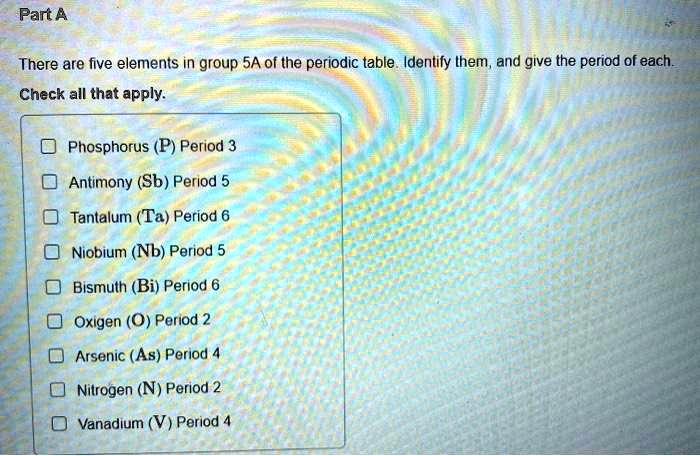Part A There are five elements in group 5A of the periodic table. Identify them, and give the period of each. Check all that apply. Phosphorus (P) Period 3 Antimony (Sb) Period 5 Tantalum (Ta) Period 6 Niobium (Nb) Period 5 Bismuth (Bi) Period 6 Oxigen (O) Period 2 Arsenic (As) Period 4 Nitrogen (N) Period 2 Vanadium (V) Period

The Correct Answer and Explanation is:
The five elements in group 5A (group 15 using IUPAC numbering) of the periodic table and their corresponding periods are:
- Nitrogen (N) — Period 2
- Phosphorus (P) — Period 3
- Arsenic (As) — Period 4
- Antimony (Sb) — Period 5
- Bismuth (Bi) — Period 6
These five elements belong to the nitrogen family, also referred to as the pnictogens. Each of them has five valence electrons, resulting in similar chemical properties and common oxidation states of −3, +3, and +5. Their classification under group 5A stems from the older North American system, where the letter A is assigned to main-group elements. In modern IUPAC nomenclature, this corresponds to group 15.
Nitrogen and phosphorus are nonmetals and primarily form covalent compounds. Nitrogen exists as a diatomic gas at room temperature, playing a vital role in biological molecules such as amino acids and nucleic acids. Phosphorus is solid and occurs in various allotropic forms including white, red, and black phosphorus, with broad applications in fertilizers and detergents.
Arsenic and antimony exhibit metalloid behavior. This means they have properties intermediate between metals and nonmetals. Arsenic is toxic and used in semiconductors and pesticides, while antimony is useful in flame retardants and alloys.
Bismuth, a heavy post-transition metal, completes the group. It is the least toxic of its heavy metal peers and is used in cosmetics, pharmaceuticals, and low-melting alloys.
The other elements listed—oxygen (group 6A), tantalum and niobium (group 5B transition metals), and vanadium (group 5B)—do not belong to group 5A and thus should not be selected. Each serves distinct roles across the periodic table unrelated to the nitrogen family’s chemical trends.
